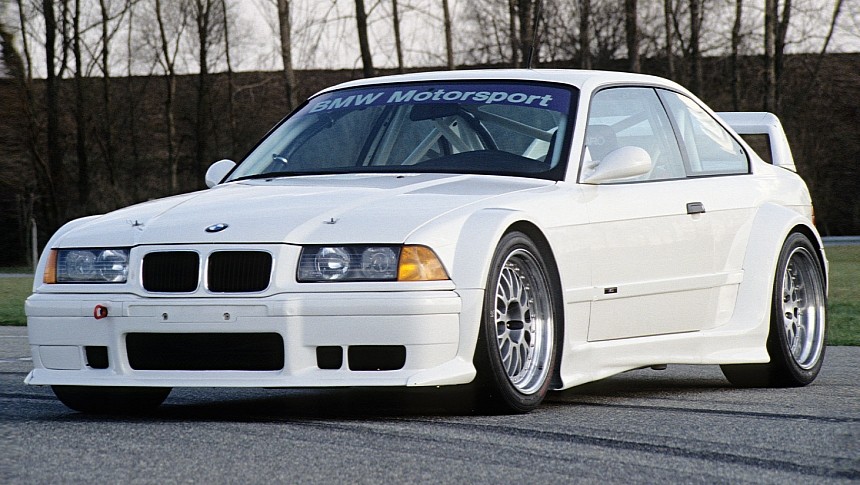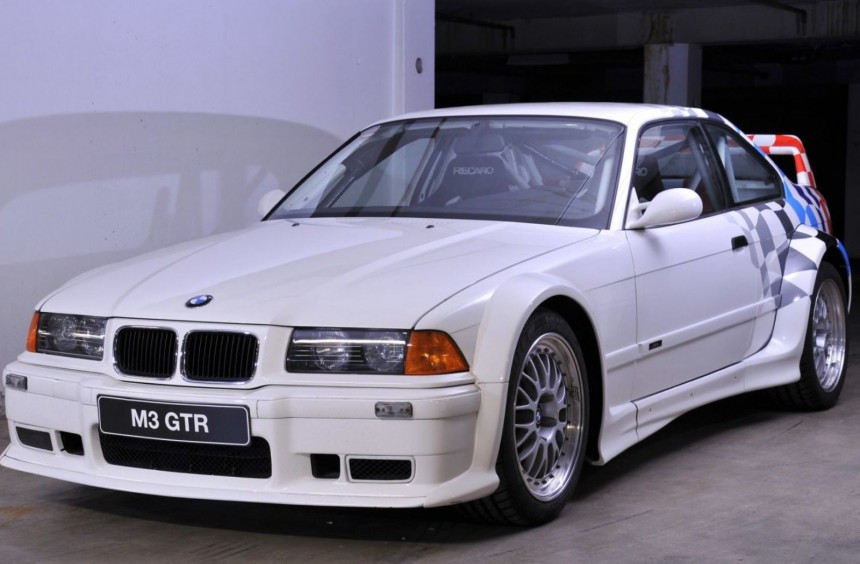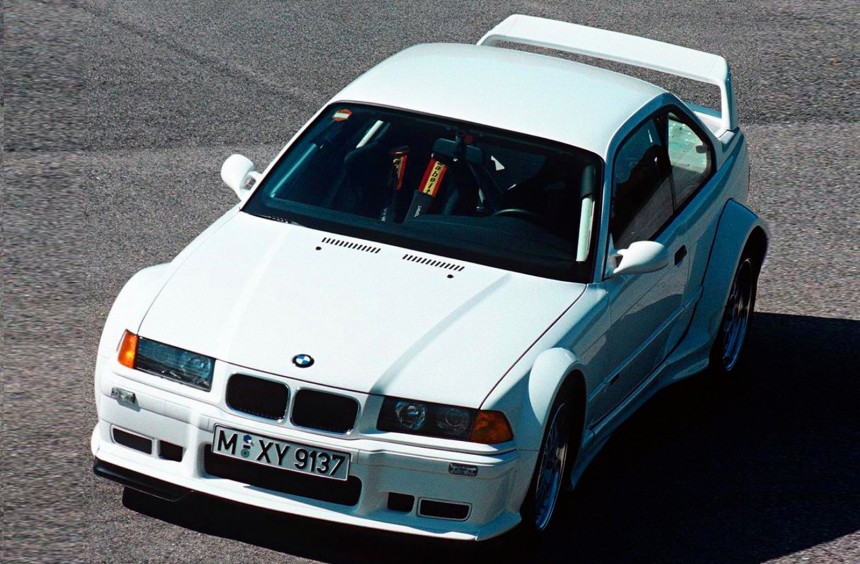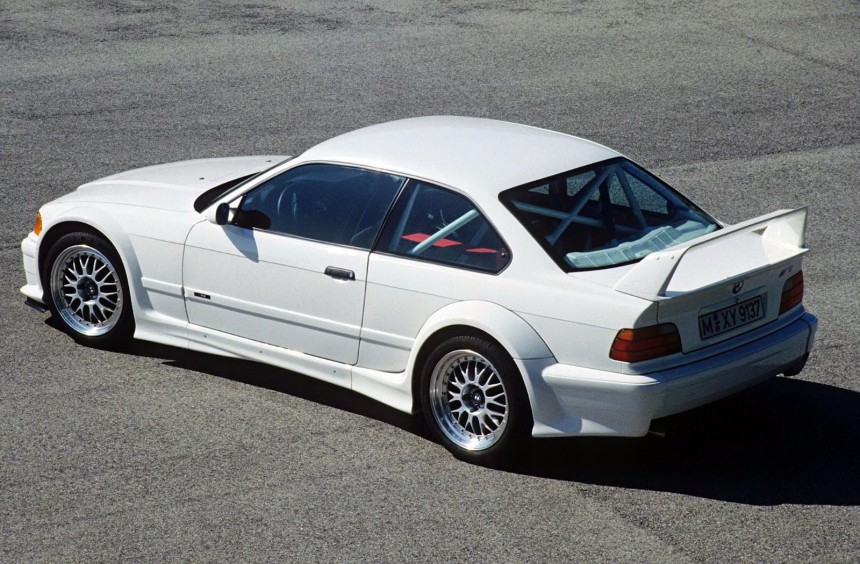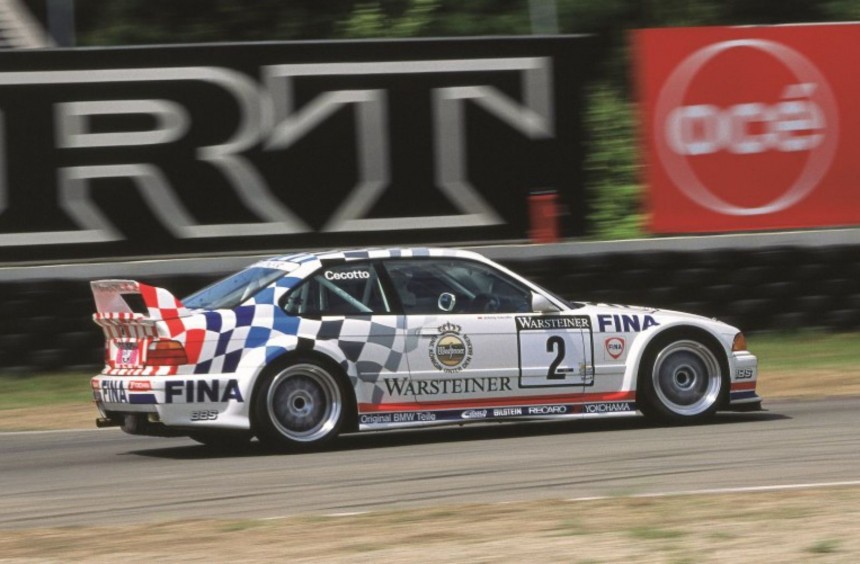Not to be confused with its similar E46 successor, who starred in the original Need for Speed: Most Wanted video game, the E36 M3 GTR was BMW's original thoroughbred street-legal race car that we wish made it into production.
In 1972, the German carmaker founded BMW Motorsport GmbH, a division that became responsible for some of the most iconic race cars and high-performance street machines developed in Europe over the next fifty years.
Arguably the most legendary member of the BMW M family remains the E30 M3 which debuted at the 1985 Frankfurt Motor Show. The idea behind the project was to transform the plebian E30 3 Series into a legitimate DTM (Deutsche Tourenwagen Meisterschaft) and Group A Touring Car contender.
But, as homologation rules of the era dictated that 5,000 units of a similar road car had to be built, the M division created the very first M3 offered to the public.
Boasting a thoroughly improved body, a revamped chassis, and a race-bred four-cylinder, the E30 M3 became a marketing hit on the showroom floor and a highly successful race car on the track where it dominated virtually every competition it took part in.
As the 1990s came about, it was time for a successor, but BMW chose a different approach for its development. The second iteration of the M3 based on the new E36 3 Series was no longer a homologation special created with motorsport dominance in mind. Instead, the new model became a refined, upscale high-performance car tailored for a broader audience.
This proved to be a winning formula as BMW ended up selling far more E36 M3s than it did during the production run of the initial model. More importantly, the new car was also a hit in the North American market, where the German manufacturer struggled to meet demand with the E30 M3.
Sales figures aside, M stood for Motorsport, so the division didn't give up on its involvement in racing. Though it continued to campaign the E30 M3 in the DTM, the emergence of new grand touring (GT) competitions like the German ADAC GT Cup demanded a new car.
In this brand-new series set to kick off in 1993, the homologation requirements were much more permissive, allowing manufacturers to enter thoroughly-modified versions of production cars as long as they built a single identical street-legal version.
Since BMW wanted to compete in this new series, which was highly anticipated by German motorsport fans, they proceeded to develop a race car based on the new E36 M3 called GTR. Consequently, the engineering team also assembled a Strassenversion (Street Version) that became the most outrageous road-going E36 ever created.
Like its track sibling, the street-legal M3 GTR was built around a seam-welded two-door coupe body stripped of sealing and sound-deadening materials.
To enhance its aerodynamic efficiency, it received a dramatic widebody comprised of larger, more aggressive bumpers, massive wheel arch extensions connected by equally beefy side skirts, and a big adjustable spoiler that sat on the raised trunk lid - a similar modification to what the E30 M3 had received in the past.
This unique widebody never made on a production M3 nor in BMW M's performance parts catalog. However, enthusiasts worldwide spent a lot of time and money replicating it in the years that followed, which gave birth to some pretty accurate GTR replicas.
Inside, the GTR Strassenversion had no convenience features that made it more comfortable than its race-bound counterparts. That meant it had no carpeting, electric windows, sound system, or backseat.
Instead, it only featured a stipped dashboard, a racing steering wheel, a massive roll cage, and a pair of Recaro competition buckets with Sabelt harnesses.
The monstrous German one-off sat on 18-inch Japanese center-lock wheels designed by BBS with Yokohama slicks wrapping around them.
Apart from the cosmetic modifications, the stock M3 chassis it was based on got its fair share of upgrades.
The structure was stiffened around critical areas, while its fully-independent suspension was taken to competition standards using race-spec springs, shocks, and anti-roll bars.
The braking system was also carried over from the race cars, being improved to cope with the rigors of racing. Nevertheless, the ABS unit of the stock M3 was removed since the technology was prohibited in the GT competitions of the era.
Under the hood, both the race cars and the Strassenversion hid the same naturally-aspirated S50B30 DOHC 24-valve inline-six with VANOS variable valve timing that powered the first batch of EU-spec production M3s. However, the unit was bored out from 2,990 cc to 3,018 cc. This and other upgrades pushed output from the stock 282 hp to around 350 hp.
The engine was mated to a six-speed racing transmission instead of the 5-speed close-ration unit initially available in the mass-produced M3.
The M3 GTR race car rose to the expectations set by BMW's M division, and in some ways, it even exceeded them.
After completing both the race car and the street version required for homologation in 1992, the M3 GTR took part in the inaugural German ADAC GT Cup season. It proved extremely good from the start, winning six of the eight races and bringing the 1993 title to BMW works driver Johnny Cecotto.
Although BMW retired the E36 M3 GTR from its factory program a year later, the race cars delivered to privateers continued to race in various competitions across the globe, where they were very successful. In the US, one of these cars won the 1997 and 1998 Drivers' and Manufacturers' Championships in the SportsCar GT2 class.
Compared to other exciting one-offs, BMW was very secretive about the E36 M3 GTR Strassenversion, and more than 30 years after it was completed, details about its whereabouts are still murky. Since the manufacturer has never showcased the car at any recent events, many have theorized that it has been dismantled. Some sources state that it was gifted to the Quandt family, who were major shareholders in BMW and kept the company from going bankrupt in the early 1960s.
Regardless of its whereabouts, the E36 M3 GTR Strassenversion remains one of the most outrageous one-offs that BMW has ever built, and it continues to be an icon, particularly among fans of the E36 generation.
Arguably the most legendary member of the BMW M family remains the E30 M3 which debuted at the 1985 Frankfurt Motor Show. The idea behind the project was to transform the plebian E30 3 Series into a legitimate DTM (Deutsche Tourenwagen Meisterschaft) and Group A Touring Car contender.
But, as homologation rules of the era dictated that 5,000 units of a similar road car had to be built, the M division created the very first M3 offered to the public.
Boasting a thoroughly improved body, a revamped chassis, and a race-bred four-cylinder, the E30 M3 became a marketing hit on the showroom floor and a highly successful race car on the track where it dominated virtually every competition it took part in.
As the 1990s came about, it was time for a successor, but BMW chose a different approach for its development. The second iteration of the M3 based on the new E36 3 Series was no longer a homologation special created with motorsport dominance in mind. Instead, the new model became a refined, upscale high-performance car tailored for a broader audience.
This proved to be a winning formula as BMW ended up selling far more E36 M3s than it did during the production run of the initial model. More importantly, the new car was also a hit in the North American market, where the German manufacturer struggled to meet demand with the E30 M3.
Keeping the new M3 involved in motorsport
In this brand-new series set to kick off in 1993, the homologation requirements were much more permissive, allowing manufacturers to enter thoroughly-modified versions of production cars as long as they built a single identical street-legal version.
Since BMW wanted to compete in this new series, which was highly anticipated by German motorsport fans, they proceeded to develop a race car based on the new E36 M3 called GTR. Consequently, the engineering team also assembled a Strassenversion (Street Version) that became the most outrageous road-going E36 ever created.
Equipped with a dramatic widebody that became iconic
To enhance its aerodynamic efficiency, it received a dramatic widebody comprised of larger, more aggressive bumpers, massive wheel arch extensions connected by equally beefy side skirts, and a big adjustable spoiler that sat on the raised trunk lid - a similar modification to what the E30 M3 had received in the past.
This unique widebody never made on a production M3 nor in BMW M's performance parts catalog. However, enthusiasts worldwide spent a lot of time and money replicating it in the years that followed, which gave birth to some pretty accurate GTR replicas.
Inside, the GTR Strassenversion had no convenience features that made it more comfortable than its race-bound counterparts. That meant it had no carpeting, electric windows, sound system, or backseat.
Instead, it only featured a stipped dashboard, a racing steering wheel, a massive roll cage, and a pair of Recaro competition buckets with Sabelt harnesses.
The monstrous German one-off sat on 18-inch Japanese center-lock wheels designed by BBS with Yokohama slicks wrapping around them.
An improved chassis and a larger six-cylinder
The structure was stiffened around critical areas, while its fully-independent suspension was taken to competition standards using race-spec springs, shocks, and anti-roll bars.
The braking system was also carried over from the race cars, being improved to cope with the rigors of racing. Nevertheless, the ABS unit of the stock M3 was removed since the technology was prohibited in the GT competitions of the era.
Under the hood, both the race cars and the Strassenversion hid the same naturally-aspirated S50B30 DOHC 24-valve inline-six with VANOS variable valve timing that powered the first batch of EU-spec production M3s. However, the unit was bored out from 2,990 cc to 3,018 cc. This and other upgrades pushed output from the stock 282 hp to around 350 hp.
The engine was mated to a six-speed racing transmission instead of the 5-speed close-ration unit initially available in the mass-produced M3.
A successful racing career
After completing both the race car and the street version required for homologation in 1992, the M3 GTR took part in the inaugural German ADAC GT Cup season. It proved extremely good from the start, winning six of the eight races and bringing the 1993 title to BMW works driver Johnny Cecotto.
Although BMW retired the E36 M3 GTR from its factory program a year later, the race cars delivered to privateers continued to race in various competitions across the globe, where they were very successful. In the US, one of these cars won the 1997 and 1998 Drivers' and Manufacturers' Championships in the SportsCar GT2 class.
Compared to other exciting one-offs, BMW was very secretive about the E36 M3 GTR Strassenversion, and more than 30 years after it was completed, details about its whereabouts are still murky. Since the manufacturer has never showcased the car at any recent events, many have theorized that it has been dismantled. Some sources state that it was gifted to the Quandt family, who were major shareholders in BMW and kept the company from going bankrupt in the early 1960s.
Regardless of its whereabouts, the E36 M3 GTR Strassenversion remains one of the most outrageous one-offs that BMW has ever built, and it continues to be an icon, particularly among fans of the E36 generation.
